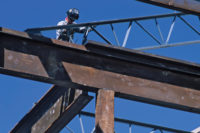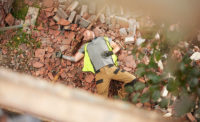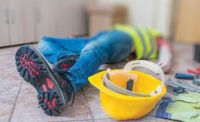OSHA’s fall protection training requirements for the construction industry standard was the eighth-most-frequently cited agency standard in FY 2018.
Enforcement citations FY 2018: 1754
Number of inspections: 1,697
Proposed penalties: $2,522,562
Most frequently cited industries
- Construction
- Wholesale trade
- Manufacturing
- Waste management and remediation
- Real estate and rental and leasing
- Retail trade
- Arts, entertainment and recreation
Fatality case studies
- On Monday, June 30, 2014 at 11:48 am a 60-year-old male roofer was removing shingles from a church roof. As he leaned back on the leading edge of the roof, his safety rope snapped, causing him to fall 29 feet 11 inches to hard dirt below. Although the victim was wearing a safety harness, it was not considered a personal protection fall arrest system and he was not tied off properly. Emergency services were called and the victim was in cardiac arrest when emergency personnel arrived. The victim died 20 minutes later in the hospital from injuries sustained from the fall.
- In fall 2012, a male horse breeder in his 70s died when his coat became entangled in the twine of a bale he was physically throwing from the hayloft. He fell 11-12 feet from the loft onto hard packed dirt. The decedent was working alone up in the loft. His spouse was feeding the horses below. She heard a “thud” but thought it was a bale landing on the ground. She went to investigate a few minutes later. She saw her husband lying on the ground. She ran to their home to call emergency response. Emergency response arrived and transported him to a local hospital where he died the next day.
Background
Falls are the leading cause of death in construction. In 2016, there were 370 fatal falls to a lower level out of 991 construction fatalities (BLS data). These deaths are preventable.
Since 2012, OSHA has partnered with the National Institute for Occupational Safety and Health (NIOSH) and its National Occupational Research Agenda (NORA) - Construction Sector on a Fall Prevention Campaign to raise awareness among workers and employers about common fall hazards in construction, and how falls from ladders, scaffolds and roofs can be prevented.
Hazard protection
Plan ahead to get the job done safely.
When working from heights, employers must plan projects to ensure that the job is done safely. Begin by deciding how the job will be done, what tasks will be involved, and what safety equipment may be needed to complete each task.
When estimating the cost of a job, employers should include safety equipment, and plan to have all the necessary equipment and tools available at the construction site. For example, in a roofing job, think about all of the different fall hazards, such as holes or skylights and leading edges, then plan and select fall protection suitable to that work, such as personal fall arrest systems (PFAS).
Provide the right equipment.
Workers who are six feet or more above lower levels are at risk for serious injury or death if they should fall. To protect these workers, employers must provide fall protection and the right equipment for the job, including the right kinds of ladders, scaffolds, and safety gear.
Use the right ladder or scaffold to get the job done safely. For roof work, if workers use personal fall arrest systems (PFAS), provide a harness for each worker who needs to tie off to the anchor. Make sure the PFAS fits, and regularly inspect it for safe use.
Train everyone to use the equipment safely
Every worker should be trained on proper set-up and safe use of equipment they use on the job. Employers must train workers in recognizing hazards on the job. See OSHA’s educational materials and resources page for posters, factsheets, and other training materials.
Key standard takeaways
- The employer shall provide a training program for each employee who might be exposed to fall hazards. The program shall enable each employee to recognize the hazards of falling and shall train each employee in the procedures to be followed in order to minimize these hazards.
- Training must be conducted by a competent person. "Competent person" means one who is capable of identifying existing and predictable hazards in the surroundings or working conditions which are unsanitary, hazardous, or dangerous to employees, and who has authorization to take prompt corrective measures to eliminate them.
- The employer shall assure that each employee has been trained, as necessary, by a competent person qualified in the following areas:
- The nature of fall hazards in the work area;
- The correct procedures for erecting, maintaining, disassembling, and inspecting the fall protection systems to be used;
- The use and operation of guardrail systems, personal fall arrest systems, safety net systems, warning line systems, safety monitoring systems, controlled access zones, and other protection to be used;
- The role of each employee in the safety monitoring system when this system is used;
- The limitations on the use of mechanical equipment during the performance of roofing work on low-sloped roofs;
- The correct procedures for the handling and storage of equipment and materials and the erection of overhead protection; and
- The role of employees in fall protection plans.
- The employer shall verify compliance by preparing a written certification record. The written certification record shall contain the name or other identity of the employee trained, the date(s) of the training, and the signature of the person who conducted the training or the signature of the employer. If the employer relies on training conducted by another employer or completed prior to the effective date of this section, the certification record shall indicate the date the employer determined the prior training was adequate rather than the date of actual training.
- The latest training certification shall be maintained.
- "Retraining” — When the employer has reason to believe that any affected employee who has already been trained does not have the understanding and skill required, the employer shall retrain each such employee. Circumstances where retraining is required include, but are not limited to, situations where:
- Changes in the workplace render previous training obsolete; or
- Changes in the types of fall protection systems or equipment to be used render previous training obsolete; or
- Inadequacies in an affected employee's knowledge or use of fall protection systems or equipment indicate that the employee has not retained the requisite understanding or skill.
Compliance resources
- OSHA Fall from a Telecommunications Tower (PDF). OSHA FATAL Facts No. 7, (2014).
- OSHA Fall Prevention Training Guide – A Lesson Plan for Employers (PDF). A Spanish version (PDF) is also available.
- OSHA Alliance Program Toolbox talks and Training products:
- Aerial Devices and Elevating Equipment
- Fall Protection
- Ladder Safety
- Toolbox Talk: Fall Protection (PDF). A Spanish version (PDF) is also available.
- CPWR: Stop Construction Falls



